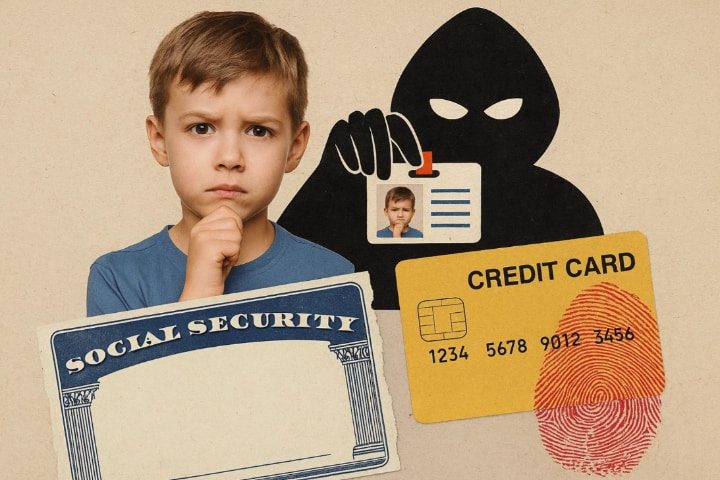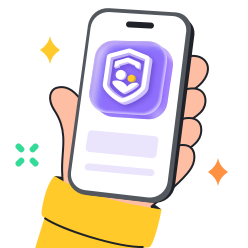Identity theft is known as identity fraud. It is a means of unlawfully assuming another’s identity, by using false pretenses. Child identity theft is like someone in possession of your child’s personal information, such as their social security number to use it to commit fraud. This can be one of the hidden crimes that can fly under the radar for years before the families are forced to discover it when it interferes with college applications or credit approvals. The knowledge of what is child identity theft and why it’s important prior to identity scams will put you ahead of thieves.
What is child identity theft?



Well, identity theft in children happens when some other person uses a child’s complete personal data, or name, date of birth, social security number, to open accounts, or apply for benefits, or to commit fraud in the child’s name. In most cases, children do not apply for credit until the late teens so the criminals take advantage of this clean slate. The child identity theft definition makes one thing very clear, that is, these criminals do it with regard to the SSN of newborns, pile up debts, or even file taxes. Often the victims are not aware until well into adulthood that they have poor credit or sudden bills. This silent crime will damage the future credit profile and employment prospects of the child and can also deny him or her government benefits eligibility. This information explains to you precisely the concept of child identity theft definition.
Ensure a safe online environment for teens with the parental control.
How does child identity theft occur?
Thieves use several easy methods to grab your kid’s data. The common ones include:
- Data breaches at schools or healthcare providers expose sensitive personal and medical information.
- Phishing scams or fake apps trick families into sharing SSNs or birthdates.
- Oversharing information on social media platforms reveals personal details like full name, home address and birthday.
- Stolen documents, pen drives, a lost school form or an unlocked tablet give thieves direct access.
Why children are prime targets for identity theft?
Criminals love long windows of unused identities to abuse, and that’s why children attract thieves. A newborn’s Social Security number is inactive until the time when the child needs the credit, usually 18 years after when he/she is given birth to. That then gives thieves time to open accounts, build up debt and, in some cases, claim government benefits all undetected.
You aren’t able to check your child’s credit the same way. An unauthorized account on an under-18 has the least chance of being noticed by anyone as the under-18 possesses little or no credit history. Before your child needs a credit card or a student loan, the damage may have gone deep. Lenders will use credit scores and interest rates to compensate for that or tank the mortgage application altogether.
They also take advantage of the trust of parents. They hunt for kids’ data from school records, some playground Wifi scams, and even neighbors’ hand me down devices. The minors are an accessible and convenient ‘blank check’ in the matter of identity scams because they are not routinely being monitored.
Red flags that your child’s identity may be stolen?
Watch out for these warning signs:
1. Credit offers addressed to your child
Pre-approved credit card offers or any other type of finance related mail that your child receives is not something you want to ignore. Normally, you won’t have a credit file as a minor. If you see this, it means that someone used their identity fraudulently. When they don’t have a file to report, contact the credit bureaus and take immediate steps to protect their information.
2. Collection calls or bills for accounts you never opened
If you get collection calls or see bills for things your child never purchased, this is a red flag of identity theft by your child’s name. This probably means some kids wouldn’t have debts so someone opened fraudulent accounts in their name. The quickest way to start the recovery process is to document all calls, request written details and report the activity to the credit bureaus and the FTC.
3. Enrollment issues
If your child is denied enrollment into school or government programs (such as Medicaid or SNAP) because he or she has an open account, it is evidence that your child’s SSN is being misused. You can contact the relevant agency, document the incident, or report identity theft to the FTC, which investigates and resolves the issue and informs the credit bureaus.
4. IRS notices
Receiving IRS letters about tax filings or unpaid taxes in your child’s name means someone may be using their SSN to commit tax fraud. Do not ignore the notice. Contact the IRS Identity Protection Unit, report the incident at IdentityTheft.gov, and monitor your child’s credit for further misuse.
5. Student loan denials
The first sign you might get that your teen has been a victim of long term identity theft is that he or she has been denied student loans or financial aid as a result of a bad credit rating. If there are inaccurate entries, request a credit report under your child’s SSN and dispute them immediately using the FTC and the appropriate credit reporting agencies.
The consequences of children’s identity being stolen
The damage from child identity theft can stay hidden for years, leaving your child with unexpected debt, damaged credit scores and big legal hassles. Anything against them like a criminal record or unpaid bills would follow them into their adulthood. Also, it could affect them when they apply for a job, a car loan or purchase a house. All of this causes stress to the families, legal fees and time to recover.
These criminals often go after youngsters’ credit, because it’s usually untouched and unmonitored. They also open credit accounts in the stolen identity, or apply for government benefits, or commit tax fraud in the stolen identity. In many instances, it’s not discovered until the child applies for a first job, driver’s license, or student loan, by which time extensive damage has been done.
What to do if your child’s identity is stolen?
- Contact credit bureaus (Experian, Equifax, TransUnion)
Request a credit freeze and a manual search for your child’s SSN. Provide your ID, proof of address, child’s birth certificate, and SSN. This freeze prevents new credit accounts from being opened in your child’s name.
- Report to the Federal Trade Commission
Fill out a child identity theft report to the FTC and get a recovery plan. The FTC will generate an Identity Theft Report that serves as an official statement of the crime.
- File a police report
Provide the FTC Identity Theft Report and any supporting documents to a police department. This creates a legal record that can help in dealing with creditors and disputing accounts.
- Notify companies where fraud occurred
Ask fraud departments to close accounts and send written confirmation. Request that they mark the accounts as fraudulent and block further use.
- Monitor accounts
Check bank statements, school financial aid portals, and utility providers for unexpected activity. Set alerts for unusual activity and review accounts weekly for added security.
- Secure documents
Store SSN cards, birth certificates, and school forms in locked files. Shred old forms. Consider using a fireproof lockbox or secure digital vault for important documents.
- Follow up
Keep copies of all correspondence. Confirm removals of fraudulent accounts and lift freezes when the child turns 16. Regular follow-ups ensure all issues are fully resolved and prevent reoccurrence.
How to protect your children from identity theft
Limiting data sharing
Don’t put full names or birthdates or Social Security numbers (SSNs) on the Internet. Identity thieves can even put together seemingly harmless bits of information. Stay away from tagging your child in a public post and from publishing school info, home addresses and geotagged pictures. As with privacy, be careful about what kind of settings are used and be sure to check who can actually see what happens on your social media feed.
Securing mobile and computer devices
Make sure your child uses a different password for every account he or she uses and changes them often. Wherever feasible enable two-factor authentication (2FA) for an additional layer of protection. Make sure to keep the operating systems, apps, and antivirus software of the devices up to date as hackers exploit the existing security bugs. Devices should always be locked when not in use.
Shredding documents
The documents with sensitive information should be destroyed before disposing of them. This can involve school forms, old report cards, medical records and anything that has insurance details or address. Personal data is a good thing to dig through trash for by identity thieves. For better security, use a cross cut shredder and dispose of paper regularly.
Checking credit reports yearly
Children shouldn’t even have credit reports; if they do, especially, it could mean that someone has stolen their identifying information from them. You may also request that a manual search of your child’s SSN be done by major credit bureaus (Experian, Equifax, TransUnion). If there is a report, keep up with it immediately. They were caught annually before their financial future was damaged by fraud.
Teaching digital literacy
Make sure your child uses a different password for every account he or she uses and changes them often. Wherever feasible enable two-factor authentication (2FA) for an additional layer of protection. Make sure to keep the operating systems, apps, and antivirus software of the devices up to date as hackers exploit the existing security bugs. Devices should always be locked when not in use.
Use parental control tools for additional safety
There are parental control apps for extra security purposes. With these apps, you can block suspicious apps, filter websites, set the screen time and get an alert if your little ones do something unusual. The reason why these tools, like the FlashGet Kids stand out from many is because they provide real-time content filtering within apps, app usage report, location tracking as well as instant alerts on risky sites or unknown data requests. This trusted tool can let you be aware of your child’s digital life and stop digital identity scams before they happen.



Final words
A child’s identity theft is a big issue, leaving consequences for a lifetime. This makes it easier for you to know how it works and how it can protect your family from hidden threats. Stay involved: check out what your credit activity is, keep personal documents out of the wrong hands, and educate your children about internet safety. All this is enough to understand what is child identity theft.
You can safeguard your child’s personal information by promoting digital literacy, utilizing parental control tools such as FlashGet Kids. These tools help you know how your devices are being used. It also helps you limit exposure to the dangers of the internet and help alert you of potential threats. Early action is key: by staying vigilant, you can prevent long-term damage, protect your child’s credit future, and ensure greater peace of mind for your whole family.
FAQs
An example of child identity theft is when a criminal uses a child’s Social Security Number to open a credit card account. The thief accumulates large debts under the child’s name, which often go unnoticed for years until adulthood.
Child identity theft occurs because criminals target the unused SSNs of minors, who usually have clean credit histories. Since parents rarely monitor their children’s credit, these fraudulent accounts can remain active and undetected for an extended period, making children ideal targets.
The best defense against child identity theft includes freezing your child’s credit with major credit bureaus, monitoring their credit reports annually. Also, safeguards all personal information, and uses strong parental controls on digital devices to prevent unauthorized access to sensitive data and online scams.

